This post may contain affiliate links. Please read our disclosure policy.
Here to kick off yet another new week, Ask a Sneakerhead is back with its latest installment. This time around, AASH caught up with Mark Shin to chop it up about sneakers. Having interned for Nike and worked with adidas, Mark shared some insight on the customer, retail and corporate happenings within the vastly growing culture. Along with touching on how he first got into sneakers, Mark also shared his prediction of what the future of sneakers could possibly look like. Read on after the jump to check out the entire interview and be sure check back with Nice Kicks next Monday for a brand new installment of Ask a Sneakerhead.
Nice Kicks: Having dabbled in the customer, retail and corporate aspects of the sneaker world, what would you say continues to be the main catalyst in the continued growth/interest in the sneaker culture?
Mark Shin: I think the sneaker culture has changed tremendously from when I started collecting back in the mid 80’s. When I was younger, it was strictly based on sports builds. The word lifestyle did not exist. I wanted Air Jordans so bad because that was the closest thing I could get to being like Mike. When I was first becoming a sneakerhead, I was given one pair of shoes for the whole school year, so I took care of those shoes as if they were the most precious possession in the world. I felt the shift change in the mid 80’s when brands such as adidas, Nike, Puma, Reebok and more started to diversify their product to be made for specific activities. I also saw casual shoes starting to come into play. Shoes that were functional for sports activities now had more cache’ to be worn off the field/courts.
Now sneaker culture has gone so mainstream and world wide. Sneakers are now viewed more for fashion than function. For me, it was McEnroe, Bo Jackson, Jordan, Dan vs Dan, etc. Now it’s Kanye, LeBron, KD, Pharrell and still Jordan. Sports, music and fashion icons are not just regionalized anymore but worldwide. Fashion trends are now global. You see What Did You Wear (WDYW) posts showing what people are wearing all over the world. My WDYW was based on who I saw on a daily basis or who was on TV. With the world shrinking due to the internet, being able to see what’s going on in Japan while living in a MidWest town has really shifted the sneaker culture.
So you throw this all into a blender and you now see what we have now. We have a global community that has many platforms to share information, who then are able to create engagement on a global level. This is very evident in the sneaker community. Back in the day, when an Asia-exclusive colorway dropped, the only way I knew about it was when my cousin in Korea would tell me or I would travel to Korea and see it in person. Now you just pull up a site like Nice Kicks and there it is. We truly live in a global world that definitely has helped grow and create a higher level of interest in the sneaker culture.
Nice Kicks: A diehard sneakerhead, when did you first start collecting kicks? What’s the crown jewel of your collection? What pairs of kicks do you wish was a part of your collection right now?
Mark Shin: I first got the bug in the mid 1980’s with the Nike Air Jordans. I couldn’t afford a pair of Air Jordans and my parents weren’t willing to pay $84.99 for a pair of sneakers. I remember my mom saying “There is no way we are spending $80 on sneakers.” I remember getting a pair of PUMA Baskets at a local sports store. I remember being so bummed that it wasn’t a pair of Nike Air Jordans that I went on to write Air on the back of the heel. I wanted the Jordans so bad. I wanted to be like Mike and felt the shoes were the most attainable way to do it. I remember working my ass off in the summer to raise enough money to buy my first pair of Jordans. I kept those shoes so clean. I wore them until the outsoles wore through to the midsoles and even kept them for another 15 years before I had to throw them away. Ever since then, I’ve been addicted to sneakers.
My sneaker habit got worse when I got my first real job at Athlete’s Foot in college. I was pretty much working for sneakers and not a paycheck. So many hot shoes were coming out. At the Athlete’s Foot, it was more of a technical store, where all the sales associates were put through Fit University to learn about the actual foot, so getting Air Jordans was not that hard. I remember hiding my size and pair in the back room, because we weren’t able to buy the shoes on release days. Luckily I had a boss who was lenient about me doing this. It became a problem as my parents were absolutely livid on how many pairs of shoes I had started to accumulate. Imagine hearing my Korean mom saying “You could pay off your school tuition with the amount of money you spend on shoes.” It became such a problem that I actually started to sneak in my sneakers as I had tried with girls. I literally would leave a pair outside my window, go into the house and then open my window to sneak my new sneakers into my room and hide them in the closet.
My passion morphed into my own business when I started Capitol 1524 in Seattle when I was 25. Owning a sneaker boutique that carried all the limited edition shoes gave me access to even more sneakers. I went through the phase of wanting what everyone thought was cool, but as I’ve gotten older, I’ve been able to focus on shoes I actually love and wear. I went from 3,000 pairs to now 150 pairs. Yeah I know, 150 pairs is still a lot.
My favorite pairs that hold sentimental value are the Air Jordan 1, 3, and 4 in their OG colorways. I have a couple pairs of shoes that I spearheaded the creation of while I worked at adidas that I keep for sentimental value. Other then that, most of the shoes I have I actually wear on a daily basis.
I’ve been lucky that there aren’t any shoes that I wish I had in my collection. I still am diehard about reading about sneakers. I look at all the new technologies, and also the retros they bring back. But I guess I’ve become an old, bitter sneakerhead. I appreciate what I have, but am a tad bit bitter to how many shoes continue to be retroed.
Nice Kicks: If you had to predict the future in regards to sneakers, what do you see? Will things remain the same? Or will we see a drastic change?
Mark Shin: I feel that the current sneaker market is quite oversaturated. I know all the signs point to the market continuing to grow, but consumers are getting smarter and smarter and realizing they don’t need 100 pairs of the same shoe in different colors. I think consumers are getting smarter and realizing that beyond the hype, there are other things to spend their money on. I feel that it’s almost becoming GAP’esque, where many people realize that if the sneaker they want isn’t all hype that with the sheer amount of shoes on the market, if you wait it will go on sale. I partially feel that the sneaker market will bottom out but it’s hard to see it changing drastically.
On the flip-side, I think as long as there is a demand on the secondary market, certain shoes will continue to be successful. I also feel that certain styles have crossed into hallowed grounds and become classic styles that will always be in demand. Also, I feel new companies like Under Armour, APL, Greats and Buscemi are disrupting the market and will continue to keep the old dogs on point. I think it’s incredible to see the growth of Under Armour and how they’ve passed brands like adidas that have such heritage. Also the rise of high fashion embracing what I call the “Cozy Boy” fashion trend has helped the sneaker market grow even more. When you see Alexander Wang, Margiela, Lanvin, Givenchy and Balenciaga making high end sneakers that are crossing over into the sneaker culture, it definitely is opening up new markets.
I also feel that sneaker companies are quite smart when it comes to marketing and creating stories to help sell product. I feel story telling helps create an emotional response that makes it more than just a sneaker, but an actual emotional product. When you can build emotional bonds with your customer, you create a type of loyalty that is hard to break.
Also with social media and everyone’s fear of missing out, sneakers can help elevate your social status to a higher level which in turn helps with the growth. You don’t know how many sneaker events I’ve been to where everyone is looking at each others feet to see what they are wearing and not looking at each other.
Lastly you are seeing icons carrying the culture forward. For me, it was Michael Jordan, and now you see stars like LeBron, Kobe and KD continuing this trend. We also see non-sports figures contributing to the culture as well. I remember Jerry Seinfeld and Will Smith wearing so much heat on their feet on their respective TV shows. Now you see this with everyone from Turtle from Entourage, to Pharrell, Rihanna and Kanye who are carrying this forward. I feel as long as this exists, sneakers will continue to thrive and grow.
Ask a Sneakerhead: Mark Shin



